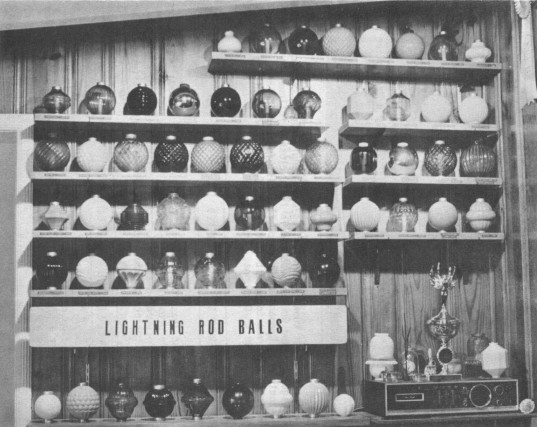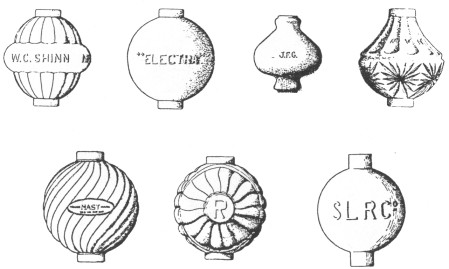WHAT IS A LIGHTNING ROD BALL?
Lightning rod balls are hollow glass shapes with openings at each end so they
may be mounted over a lightning rod. These fancy, colorful examples of the
glassmaker's art probably served only a decorative purpose and were somewhat
of a 'status symbol' in the neighborhood.

HOW OLD ARE LIGHTNING ROD BALLS?
The earliest known lightning rod ball manufacturing company was the MAST
Lightning Rod Company founded in 1840, closely followed by the Reyburn-Hunter-Foy Company of Chicago, Illinois, founded in 1849.
Production
continues even today with the George E. Thompson Lightning Rod Company still
active in Owatonna, Minnesota.
HOW MANY DIFFERENT STYLES ARE THERE?
There are at least 32 known patterns, with 15 additional variations
recognized at the present time. When it is considered that each pattern may have
been produced in at least 8 to 10 colors, it can be realized that a possible
collection could contain several hundred different balls.

WHAT IS THE MONETARY VALUE OF THE BALLS?
The money value represented by the various balls ranges from approximately
$2.50 for a plain round milk glass ball, to as high as $250.00 for dated balls
and unusual colors in other rare styles.
WHERE CAN THEY BE FOUND?
In some areas of our country, the lightning rod balls might be secured from
the roofs of homes and buildings being torn down. Most commonly, the sources
of supply would be bottle and insulator shows, antique shops, flea markets, and
through the mail from dealers who advertise in the trade magazines, such as
CROWN JEWELS, OLD BOTTLE MAGAZINE, ANTIQUE BOTTLE WORLD, BOTTLE
NEWS, and THE
ANTIQUE TRADER WEEKLY.
WHAT ARE LIGHTNING ROD INSULATORS?
Insulators associated with lightning rod protection systems are usually
spool-like in design, made of glass or porcelain, and are used to insulate the
ground wire from the building on which it is erected, and thus conduct any
electrical charge directly and safely to the ground. Some of the mentioned
insulators were manufactured by Chambers, J. H. Weston, Spratt, Hickok, Otis,
and others.
WHAT ABOUT THE WIND ARROWS?
The glass-tailed arrows seen on lightning rod protection systems serve to
indicate the direction FROM which the wind is coming. This action is caused
by the force of the wind on the flat surface of the tail.
HOW ARE THEY DISPLAYED?
As seen in the picture, the balls are placed on small 5/8" dowels so
they will not roll from the shelf. They can also be attractively displayed on
lightning rods or "stacked" on long vertical dowels. One of the more
unique displays involved macrame, and the balls were used as decoration for a
hanging planter.
For an in-depth look at Lightning Rod Balls, read the following: "Lightning Rod Balls", by Dale Frazier, Hutchinson, Kansas, in the
March, 1977
issue of OLD BOTTLE MAGAZINE, pp. 14-21.


































































